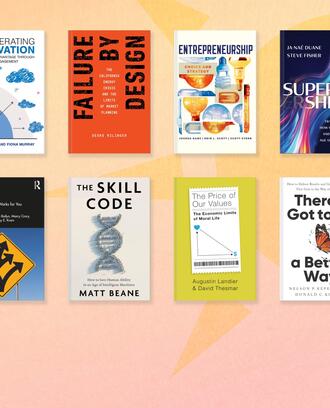Credit: aurielaki / iStock
Values-based businesses — and the backlash against them — can feel very of-the-moment, but the concept has been around for decades.
In the 1950s, IBM took a stand, saying it was committed to supporting a racially integrated workforce, even in states where segregation was commonplace and legal. Ultimately, a decade before the passage of the Civil Rights Act, white and Black employees worked side by side in IBM’s new plants in North Carolina and Kentucky.
“IBM succeeded in getting those facilities integrated by standing up for their values,” said Daniel Aronson, author of “The Value of Values: How Leaders Can Grow Their Businesses and Enhance Their Careers by Doing the Right Thing,” published by MIT Press.
In a recent webinar hosted by MIT Sloan Management Review, Aronson spoke about how companies from across industries can benefit from running a business based on values, whether those values are environmental-, social-, or governance-related.
There are obvious and hidden benefits to building a values-based business, Aronson said. Businesses can prosper from both by following his CORE framework — which stands for Customers, Operations, Risks, and Employees.
Customers: To build trust, show them your values
Consumers are the crux of a business, so that’s where a values-based approach should start, Aronson said. If you build trust and loyalty with customers, the other planks of the framework should easily fall into place.
Consider Tony’s Chocolonely, a company whose reason for being is to create change for the better in the cocoa supply chain. The Dutch confectionery calls itself “a social impact company that makes chocolate, not the other way around.” Last year, the its revenue grew 23%, to over $162 million, despite competition from more established brands.
Along the same lines, a cleaning products company discovered that once customers and prospects learned of its climate actions, they reported that its products smelled better. “Hearing about the values and seeing that values connect [to the product] changed their experience of the product, and this changes sales,” Aronson said.
On the flip side, “if customers don’t know that you share their values, then they can’t prefer you for that reason,” Aronson said. That’s why your first step should be articulating your values to your customers, followed by monitoring and measuring their actions, expectations, and values.
Operations: A values lens can boost efficiency
When companies evaluate operations through the lens of their values, they often uncover hidden inefficiencies, Aronson said. A prime example of this is an IBM semiconductor factory that ended up shifting its operations in an effort to cut back on its water usage.
Related Articles
The factory had been bringing in large amounts of cold water from its local utility and then warming it for use in production. Elsewhere in the plant, towers cooled water that was used to lower the temperature of certain equipment. When IBM looked at its process from an environmental perspective, it realized it could save water and energy by changing its flow — using incoming cold water for cooling and existing warm water for production.
“This facility had been in place for decades, and yet they hadn’t seen this before,” Aronson said, because the problem wasn’t examined through a values lens.
When that changed, the factory realized water savings of 29% and cash savings of about three-quarters of a million dollars in “submerged” costs related to energy and treatment processes.
Aronson quoted Eric Berliner, an IBM water manager in Burlington, Vermont, who said, “When you start to think like we think, you don’t see water in the pipes. You see dollar signs.”
Risk: A values-based approach helps companies better understand their risks
As is the case with the operations component of the framework, companies often identify risks sooner when they use a values lens. That’s important, Aronson said, because climate-related incidents and disasters are likely to continue to grow and threaten to disrupt operations.
In practice, companies can start by taking a close look at the resources, relationships, and routines their business depends on and determining which ones are already under pressure from climate change and what areas need to be addressed right now.
“When you look through values lenses, you look at what the world needs and where it’s going, and you see things that are different and that are potential risks,” Aronson said. Those threats could include extreme heat, hurricanes and tropical storms, or wildfires.
Employees: Poll your workforce and quantify your progress
“If you want the best people, then you want to have values that align with [theirs],” Aronson said. “And it turns out this is also true in reverse: Values can repel as well as attract.”
And here, too, those values should be articulated and measured. “While the idea that employees want to work for a company that shares their values is intuitive, values are often not quantified,” Aronson said.
Whatever your tools or method, first find out what your current and prospective employees think of your values, he said. Do they know what company values are? Do they believe that leadership believes in them?
Then demonstrate those values to employees and prospects in the best possible ways. This might include designing experiments to track the effect of your efforts. Always be thinking about how you can better connect with your people on a values level,” Aronson suggested.
Overall, “you want to [identify] the core values that you and your customers and your employees and your stakeholders share,” Aronson said. “And you want to think, ‘What can I do that I’ll be proud of in the future, just like IBM did?’”
Read next: 3 leaders detail practices that support stakeholder and societal values



